Sunday, December 31, 2006
Feliz Año Nuevo
Saturday, December 30, 2006
Buenos Aires: Plaza de Mayo

The Plaza de Mayo is Buenos Aires's main square. It's right in front of Argentina's "White House", known as the Casa Rosada [Pink House]. The police had erected barriers across the end of the plaza near the Casa Rosada to prevent protests.
The area surrounding the Plaza de Mayo has office buildings for various government agencies and private businesses. We saw an interesting end-of-the-year tradition: office workers throw armloads of paper out the window, like giant confetti. It was the last workday of 2006 and papers filled the trees and made drifts along the curb.
Labels: Argentina, Buenos Aires
Buenos Aires: San Telmo
 San Telmo is an old neighborhood in Buenos Aires. The street are narrow and full of interesting buildings. It seems much more redeveloped than Montevideo's ciudad vieja. There are antique shops throughout the barrio selling silver mates, gaucho knives, marble pedestals, painting, and more. It hosts a well-known market on Sundays.
San Telmo is an old neighborhood in Buenos Aires. The street are narrow and full of interesting buildings. It seems much more redeveloped than Montevideo's ciudad vieja. There are antique shops throughout the barrio selling silver mates, gaucho knives, marble pedestals, painting, and more. It hosts a well-known market on Sundays. 

Labels: Argentina, Buenos Aires
Buenos Aires: Palermo
 Buenos Aires, like Montevideo, has many distinct neighborhoods. We stayed in Palermo, home to the botanical garden, a zoo founded in 1874, and several parks. We visited the Malba museum of art that features many Latin American artists, including paintings by the Uruguayan Joaquín Torres García.
Buenos Aires, like Montevideo, has many distinct neighborhoods. We stayed in Palermo, home to the botanical garden, a zoo founded in 1874, and several parks. We visited the Malba museum of art that features many Latin American artists, including paintings by the Uruguayan Joaquín Torres García.Labels: Argentina, Buenos Aires
Buenos Aires and Montevideo
 In many ways, Buenos Aires seems like a bigger, flashier, faster version of Montevideo. The biggest difference is one of scale: the greater Buenos Aires area has more than 10 million residents. This leads to many differences; Buenos Aires has city streets with 10 lanes in one direction, a university with over 300,000 students, a subway system, more shopping malls, many more skyscrapers, and generally more of everything.
In many ways, Buenos Aires seems like a bigger, flashier, faster version of Montevideo. The biggest difference is one of scale: the greater Buenos Aires area has more than 10 million residents. This leads to many differences; Buenos Aires has city streets with 10 lanes in one direction, a university with over 300,000 students, a subway system, more shopping malls, many more skyscrapers, and generally more of everything.Buenos Aires was also hotter. While both cities are on the Río de la Plata, Montevideo seems to get more of the sea breeze.

Labels: Argentina, Buenos Aires, Uruguay
Friday, December 29, 2006
To Buenos Aires
 We spent most of Friday and Saturday in Buenos Aires visiting friends from the US who have family there. We took a bus to Colonia and then the Buquebus ferry across the Río. The bus took about 3 hours and the boat took about 45 minutes.
We spent most of Friday and Saturday in Buenos Aires visiting friends from the US who have family there. We took a bus to Colonia and then the Buquebus ferry across the Río. The bus took about 3 hours and the boat took about 45 minutes.Argentinian protestors had threatened to stop the Buquebus ferry as part of their economic blockade of Uruguay during the tourist season. The protesters closed the border at Fray Bentos for the entire summer last year and they are blocking it now. The protestors announced they would expand their blockade to include the ferry, but Argentina's government intervened, so we were able to travel.
We didn't spend a lot of time in Argentina but we enjoyed what we saw. I'll post some pictures soon.
Labels: Argentina, Buenos Aires, Uruguay
Thursday, December 28, 2006
Over the river
Here are a couple of other Uruguay blogs to explore while I'm gone.
Uruguay wildlife
and some
Uruguayan photos
Labels: Argentina, video, waterfront
Wednesday, December 27, 2006
Huevos
 I first saw ñandú [ostrich] eggs in the kitchen of a rural school on my visit to the Estancia Las Cecilias . I found this egg in a field at the estancia. The size and weight were impressive.
I first saw ñandú [ostrich] eggs in the kitchen of a rural school on my visit to the Estancia Las Cecilias . I found this egg in a field at the estancia. The size and weight were impressive. On the right, is an ordinary chicken egg for comparison.
Tuesday, December 26, 2006
Santa doesn't come to every house
 The Asociación Cultural y Casa de los Inmigrantes César Vallejo collected Christmas wishes from poor childern in Montevideo and looked for donors to help. El Pais ran an article on the unmet requests a few days before Christmas.
The Asociación Cultural y Casa de los Inmigrantes César Vallejo collected Christmas wishes from poor childern in Montevideo and looked for donors to help. El Pais ran an article on the unmet requests a few days before Christmas. We called the agency and read a few of the kids' letters. One note said,"Mr. Papa Noel, This year I have been good. Would it be possible to bring me a doll?" And another said, "Dear Papa Noel: I would like a soccer ball because I like sports very much and a pair of sneakers." We did a little shopping and delivered gifts directly to a few kids on Christmas eve. They were delighted.
Living in the US, I've been fortunate to have never been in the situation where I couldn't buy a gift for my own children. (Our problem tends to be the opposite: we have so many things we can't store them all.) Economists may argue that direct gift-giving is inefficient & that a cash transfer would be more efficient, but writing a check doesn't make the same emotional connection. I was really touched seeing these kids.
It's made me think differently about the holiday season. For instance, while I love electronic gadgets, after visiting these poor children I can't read this high-tech wish list without a touch of queasiness.
Labels: economics, holidays, Uruguay
Monday, December 25, 2006
Feliz Navidad
Sunday, December 24, 2006
Feria del Libro
 During the last weeks of each December, Montevideo has a book fair in Parque Rodó. The fair opens in the evening when it's cooler and vendors sell books and very nice handicrafts. Our friend María Noel Taranto performed at the closing night concert.
During the last weeks of each December, Montevideo has a book fair in Parque Rodó. The fair opens in the evening when it's cooler and vendors sell books and very nice handicrafts. Our friend María Noel Taranto performed at the closing night concert. Watch a video clip of the performance.
Nochebuena
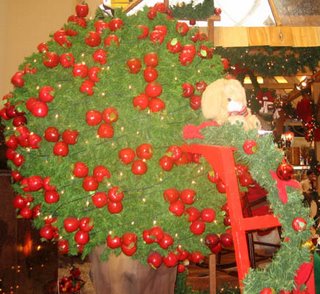 Christmas eve, or Nochebuena, is the main event of the holiday season in Uruguay. Families and friends get together for big dinners late in the evening. Kids can open their gifts after midnight. (If they open them early, the presents turn to ashes!) The shopping malls were open late the night before, for last-minute shopping. Punta Carretas Shopping was still crowded when we left at 1:00 in the morning.
Christmas eve, or Nochebuena, is the main event of the holiday season in Uruguay. Families and friends get together for big dinners late in the evening. Kids can open their gifts after midnight. (If they open them early, the presents turn to ashes!) The shopping malls were open late the night before, for last-minute shopping. Punta Carretas Shopping was still crowded when we left at 1:00 in the morning.update: At midnight on Christmas eve, it seemed like everyone in Montevideo set off fireworks. We went out to the street to watch and then went back to eat our dinner. We ate a delicious lechón. Firecrackers continued to explode throughout the night and groups of young people were still drinking on the Rambla at 8 the next morning.
Labels: customs, holidays, Uruguay
Saturday, December 23, 2006
Almacén del Hacha
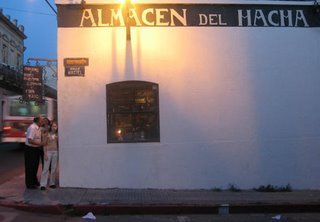 The Almacén del Hacha is a restaurant with a history in the Ciudad Vieja. They say it's the oldest bar in Montevideo. The exact date of its opening is unknown but it was sometime before 1794. It's been commemorated on a Uruguayan postage stamp and it's featured by the government's historic bar commission: Bares y almacenes con historia.
The Almacén del Hacha is a restaurant with a history in the Ciudad Vieja. They say it's the oldest bar in Montevideo. The exact date of its opening is unknown but it was sometime before 1794. It's been commemorated on a Uruguayan postage stamp and it's featured by the government's historic bar commission: Bares y almacenes con historia.My Father-in-law lived a few houses up the street several decades ago. In that time, the building had two parts: the bar and the almacén [store]. The bar sold grappa and caña and customers played truco. As a boy, he'd go to the almacén for a refuerzo de a vinten [a sandwich that cost 2 centavos]-- bread with a very thin slice of mortadella. If he had 5 centavos, they offered another sandwich with more meat.
 El hacha means the axe and the name comes from an infamous crime committed during the 18th century. On April 15, 1794, an employee named Bernardo Paniagua was killed during a robbery. The weapon? An axe. The murderer was captured in Argentina and hung in Uruguay. For over 200 years, people have referred to it as the "esquina del hacha".
El hacha means the axe and the name comes from an infamous crime committed during the 18th century. On April 15, 1794, an employee named Bernardo Paniagua was killed during a robbery. The weapon? An axe. The murderer was captured in Argentina and hung in Uruguay. For over 200 years, people have referred to it as the "esquina del hacha".Today, it's a very nice restaurant decorated with historic artifacts: an antique cash register, a Victrola gramophone, a waist-high mortar, tango posters, beer advertisements, photos of the Montevideo, and more. We had a great dinner there last night and we ate a lot. The entradas were so good that we could have skipped the main course. I particularly liked the jamon serrano, the spicy potatoes, and the choriso sausage cooked in white wine. My plato principal was entrecot en salsa Tannat (steak with a red wine sauce); very nice. I didn't have room for dessert.
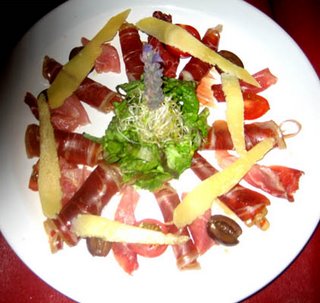
It's located at Calle Buenos Aires 202 (esquina Maciel). Telephone:915-2823 There's parking across the street; a waiter will unlock the gate,if you ask.
Labels: Colonial, food and drink, Uruguay
Friday, December 22, 2006
Turrón
 Turrón is a traditional Christmas treat in Spain. It's a nougat candy made with almonds. In Kalamazoo, we can only find the soft Italian kind. My wife's cravings for the crunchy turrón would be unsatisfied, if it weren't for the kindness of friends who bring it back from Spain for her. In Montevideo, at Christmastime, there must be a hundred varieties of turrón for sale: blando (soft), duro (hard), with almonds, peanuts, pistachio, or chocolate. If you want to try making your own, here's an online recipe.
Turrón is a traditional Christmas treat in Spain. It's a nougat candy made with almonds. In Kalamazoo, we can only find the soft Italian kind. My wife's cravings for the crunchy turrón would be unsatisfied, if it weren't for the kindness of friends who bring it back from Spain for her. In Montevideo, at Christmastime, there must be a hundred varieties of turrón for sale: blando (soft), duro (hard), with almonds, peanuts, pistachio, or chocolate. If you want to try making your own, here's an online recipe.Labels: food and drink, Uruguay
Thursday, December 21, 2006
Happy Solstice
 For those of us in the southern hemisphere, we're enjoying the longest day of the year and the start of summer. In the northern hemisphere, of course, it's the winter solstice with the longest night of the year. In either case, a good season to celebrate.
For those of us in the southern hemisphere, we're enjoying the longest day of the year and the start of summer. In the northern hemisphere, of course, it's the winter solstice with the longest night of the year. In either case, a good season to celebrate.Labels: holidays, seasons, Uruguay
Wednesday, December 20, 2006
Churros
 Churros may be my wife's favorite food. They are certainly her favorite item from the fried food group. They are a simple fried dough cooked to order and eaten hot, sprinkled with sugar. I don't think they are as common in Uruguay as they are in Madrid, but they are readily available in Montevideo. These are from a little stand in Parque Batlle. This stand uses rice oil to cook churros, but beef tallow to cook the torta fritas.
Churros may be my wife's favorite food. They are certainly her favorite item from the fried food group. They are a simple fried dough cooked to order and eaten hot, sprinkled with sugar. I don't think they are as common in Uruguay as they are in Madrid, but they are readily available in Montevideo. These are from a little stand in Parque Batlle. This stand uses rice oil to cook churros, but beef tallow to cook the torta fritas.Labels: food and drink, Uruguay
Tuesday, December 19, 2006
Primuseum
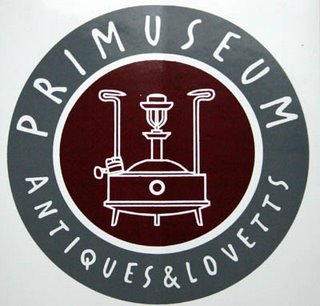 I had lunch today in a beautifully restored building in Montevideo's Ciudad Vieja that houses my host's collection of Primus stoves, lanterns, and torches. Primus is a Swedish company that's been making portable stoves and selling them worldwide for over a century. I was familiar with them from backpacking trips in high school. Apparently these stoves were typical kitchen appliances in Montevideo in the twentieth century.
I had lunch today in a beautifully restored building in Montevideo's Ciudad Vieja that houses my host's collection of Primus stoves, lanterns, and torches. Primus is a Swedish company that's been making portable stoves and selling them worldwide for over a century. I was familiar with them from backpacking trips in high school. Apparently these stoves were typical kitchen appliances in Montevideo in the twentieth century.
The building is fully equipped with a parrilla, a separate kitchen, a marble bar, and tables for plenty of friends. Carlos Gardel photos hang over the upright piano and Gardel's tango recordings play on the sound system. There's an antique cash register on the bar, shelves of antique milk bottles, an icebox built for real blocks of ice, ceramic beer bottles from defunct Montevideo breweries, old tins for mate, and much more.
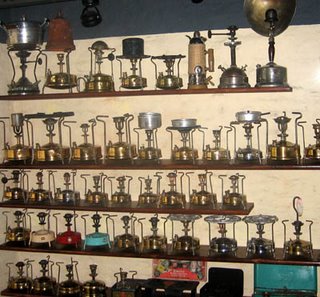 Lunch was wonderful: three types of sausage followed by matambre de cerdo and colita de cuadril from the parrilla. Once again, I was quite impressed by the generosity and hospitality of the people of Uruguay.
Lunch was wonderful: three types of sausage followed by matambre de cerdo and colita de cuadril from the parrilla. Once again, I was quite impressed by the generosity and hospitality of the people of Uruguay.Labels: Montevideo places, Uruguay
Monday, December 18, 2006
Arbol de Navidad
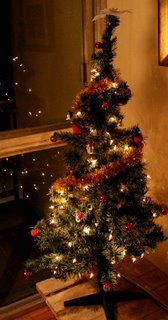
Real Christmas trees don't seem to be part of the holiday tradition in Montevideo. I haven't seen any real trees for sale, but artificial Christmas trees are available in all the big stores. They range from little Charlie Brown trees to nice six-footers. We bought a mid-sized one (maybe 4 feet tall) for our apartment. The first tree I put in the cart had an odd note handwritten on the box label: otoñal. Autumn-something? That seemed a little strange. I poked a hole in the box to peek inside-- it had brown plastic needles. I had almost bought an artificial dead tree! Anyway, I traded it for a green version and we picked out a few decorations and brought it home.
Sunday, December 17, 2006
Teatro Solís
 Teatro Solís is Montevideo's best known auditorium. It's just off Plaza Independencia. It opened in 1856 and was most recently reconstructed during 1999-2004.
Teatro Solís is Montevideo's best known auditorium. It's just off Plaza Independencia. It opened in 1856 and was most recently reconstructed during 1999-2004.  It's a beautiful theater with a small main floor and 5 tiers of boxes. None of the seats are far from the stage.
It's a beautiful theater with a small main floor and 5 tiers of boxes. None of the seats are far from the stage.We saw a ballet there this afternoon: Julio Bocca y el Ballet Argentino en ''El hombre de la corbata roja'. I enjoyed it much more than I expected.

Labels: Montevideo places, Uruguay
Saturday, December 16, 2006
British Cemetery
 The British Cemetery is in the Buceo neighborhood of Montevideo, next to the much larger Cementario del Buceo. We went to pay our respects to my wife's grandparents who are buried there. A tall obelisk with the royal crest and a marble bust of Queen Victoria sets the tone: very proper, ornate in places, and a bit antiquated. The grave markers testify to the strong British influence in Uruguay in the nineteenth century.
The British Cemetery is in the Buceo neighborhood of Montevideo, next to the much larger Cementario del Buceo. We went to pay our respects to my wife's grandparents who are buried there. A tall obelisk with the royal crest and a marble bust of Queen Victoria sets the tone: very proper, ornate in places, and a bit antiquated. The grave markers testify to the strong British influence in Uruguay in the nineteenth century.Not all of the engravings are in English. There are some in Spanish, of course, but also many in Hebrew and in German. US military influence in the 19th century is suggested by graves of sailors from the USS Ticonderoga and the USS Germantown.
Labels: Montevideo places, Uruguay
Friday, December 15, 2006
Tax closures
*Here's the original quote:
"Queremos decir que, como dice el dicho, cuando veas las barbas de tu vecino arder, pon las tuyas en remojo."
Labels: business, government, Uruguay
Thursday, December 14, 2006
Cosas artesanales

Artisan-made foods are popular in Montevideo: bread, pasta, cheese, ham, and even fish. I like supporting these small-scale producers and the quality of the products that I've tried has been very good.
Grant McCracken looks at this same trend in the US and identifies 10 reasons for the artisanal movement. Here's his first reason:
1. a preference for things that are human scale.
If once we delighted in the sheer scale of a consumer society, now we want things made in tiny batches. In the place of Morton Salt that comes from some vast industrial process, some of us prefer artisanal salt. Pam bought salt recently that came with a talkative, 4 color, brochure. Geez, I wondered, what is there to say about salt?. Plenty, apparently
I haven't seen artisanal salt in Uruguay, but I really like the breads.
Labels: business, food and drink, Uruguay
Wednesday, December 13, 2006
School's out for Summer
 Today was the last day of class at my daughter's school. Instead of signing yearbooks, the kids signed each other's t-shirts. The private schools all have formal uniforms-- sweater, tie, dress shirt, skirt or trousers-- but most days the kids just wear the gym uniform-- t-shirt and shorts with the school logo, or sweats with the school logo in the winter. These t-shirts, like the kids, are done for the year.
Today was the last day of class at my daughter's school. Instead of signing yearbooks, the kids signed each other's t-shirts. The private schools all have formal uniforms-- sweater, tie, dress shirt, skirt or trousers-- but most days the kids just wear the gym uniform-- t-shirt and shorts with the school logo, or sweats with the school logo in the winter. These t-shirts, like the kids, are done for the year.Labels: holidays, seasons, Uruguay
Tuesday, December 12, 2006
Wine in Uruguay
 I'm not generally a big wine drinker, but the Uruguayan wines I've tried have been good. They taste like moderately-priced California wines or Chilean wines. Wine can be quite inexpensive, here.
I'm not generally a big wine drinker, but the Uruguayan wines I've tried have been good. They taste like moderately-priced California wines or Chilean wines. Wine can be quite inexpensive, here.The boxed wines are high quality wines-- unlike the stereotype in the US-- and they are even cheaper than the same wine in a bottle.
Saltshaker gives this geography lesson on Uruguay's vineyards:
In regard to the wine world, some 79% of all the vineyards in Uruguay are in the areas of Canelones and San Jose, basically within about 50 miles of Montevideo. Another 18% are in the province of Colonia, the remaining 3% are scattered here and there - in Paysandú, Salto, Durazno, Rivera, and Maldonado. Most of those latter areas, however, have no more than one or two wineries, and the majority of vineyards in those areas are owned by wineries in the primary areas, grapes are sent in for processing.
Update: From the comments, I read that I missed some interesting posts on the Saltshaker blog.
I'd just note that the particular post you selected is the 3rd in a series of posts on different Uruguayan wineries that are right in a row, starting a couple of days before that one and continuing on afterwards - I had a delightful opportunity to travel with members of Uruguay's wine bureau and visit quite a few wineries in different parts of the country.
Here are some links on his visits to different wineries: Los Cerros de San Juan a Irurtia, Bodegas Carrau, Castillo Viejo, Pizzorno, Juanicó, Bouza, Viñedo de los Vientos. I recommend his whole series.
Labels: food and drink, Uruguay
Monday, December 11, 2006
Museo Torres Garcia
 Joaquín Torres García was one of Uruguay's most important painters. He had a long career, working in Brussels, Paris, Barcelona, New York, Madrid, and Montevideo. The Torres Garcia Museum is in Montevideo, near the Plaza Independencia on the Sarandi pedestrian mall. It's a fairly small museum with galleries on three floors. It's interesting to see how the style of his paintings changed over time .
Joaquín Torres García was one of Uruguay's most important painters. He had a long career, working in Brussels, Paris, Barcelona, New York, Madrid, and Montevideo. The Torres Garcia Museum is in Montevideo, near the Plaza Independencia on the Sarandi pedestrian mall. It's a fairly small museum with galleries on three floors. It's interesting to see how the style of his paintings changed over time . His paintings are also displayed at El Museo Nacional de Artes Visuales. The piece I've seen reproduced most frequently on Uruguayan handicrafts is this simple drawing.
Labels: Montevideo places, museums, Uruguay
Sunday, December 10, 2006
La Noche de las Luces
 La Noche de las Luces kicks off the holiday season in Montevideo. They'd been preparing for days: burn the grass on the point, set up the mortars, bring in the food stands, and fence off the launch area. People started gathering mid-afternoon for the fireworks at 10 pm. A policeman estimated 400,000 people would come. That's nearly a third of the city or more than 10% of Uruguay's population. People drank mate and beer, bought peanuts, chips, and cotton candy from street vendors, waded in the Rio, played soccer, and listened to music from speakers all along the beach. By dark, it was really crowded. The fireworks were great-- one of the best shows I've ever seen.
La Noche de las Luces kicks off the holiday season in Montevideo. They'd been preparing for days: burn the grass on the point, set up the mortars, bring in the food stands, and fence off the launch area. People started gathering mid-afternoon for the fireworks at 10 pm. A policeman estimated 400,000 people would come. That's nearly a third of the city or more than 10% of Uruguay's population. People drank mate and beer, bought peanuts, chips, and cotton candy from street vendors, waded in the Rio, played soccer, and listened to music from speakers all along the beach. By dark, it was really crowded. The fireworks were great-- one of the best shows I've ever seen.Here's a short video:
Labels: holidays, Uruguay, video
Saturday, December 09, 2006
Punta Brava
 Punta Brava is the southernmost point in Montevideo, perhaps in the entire country. (You can see it on thismap of Montevideo or this map.) It's a mixed-use place. There's the lighthouse, a navy base, a sewerage treatment plant, a restaurant, the fishing clubs, and parking lots where people drink mate and enjoy the view of the Río. There seems to be some kind of plan to develop a docking site for the Buquebus ferry, or maybe for cruise ships, but I'm not sure about that.
Punta Brava is the southernmost point in Montevideo, perhaps in the entire country. (You can see it on thismap of Montevideo or this map.) It's a mixed-use place. There's the lighthouse, a navy base, a sewerage treatment plant, a restaurant, the fishing clubs, and parking lots where people drink mate and enjoy the view of the Río. There seems to be some kind of plan to develop a docking site for the Buquebus ferry, or maybe for cruise ships, but I'm not sure about that.Labels: Montevideo places, Uruguay, waterfront
Friday, December 08, 2006
In bloom
 Hydrangeas bloom in mid-summer in Michigan but in Montevideo they are in full bloom now. The flowers are attractive but, for me, the best part is the litmus test: they change color from pink to blue depending on the acidity of the soil. Pink means more alkaline; blue means more acid. The change doesn't happen immediately-- it takes a whole season-- but if you grow them you can make the colors change from year to year.
Hydrangeas bloom in mid-summer in Michigan but in Montevideo they are in full bloom now. The flowers are attractive but, for me, the best part is the litmus test: they change color from pink to blue depending on the acidity of the soil. Pink means more alkaline; blue means more acid. The change doesn't happen immediately-- it takes a whole season-- but if you grow them you can make the colors change from year to year.Labels: nature, seasons, Uruguay
Thursday, December 07, 2006
Mercado del Buceo
 The small fish market at Puerto del Buceo sells the day's catch. They offer a wide variety of species: merluza, calamar, corvina, palometa, bagre, and more. We like to eat at the restaurant there (El Italiano). It's a small place, with more tables outside than inside. Sitting outside, shaded by umbrellas or the thatched roof, is definitely the way to go. The fish is very fresh-- they have their own boat-- and prepared nicely.
The small fish market at Puerto del Buceo sells the day's catch. They offer a wide variety of species: merluza, calamar, corvina, palometa, bagre, and more. We like to eat at the restaurant there (El Italiano). It's a small place, with more tables outside than inside. Sitting outside, shaded by umbrellas or the thatched roof, is definitely the way to go. The fish is very fresh-- they have their own boat-- and prepared nicely.
 My lunch today: snapper grilled on the parilla.
My lunch today: snapper grilled on the parilla.Labels: food and drink, Montevideo places, Uruguay, waterfront
Wednesday, December 06, 2006
Global Wealth
Uruguay's net worth per capita was $11,807 (based on current exchange rates.) For comparison, the US net worth per capita was $143,727. Japan had the highest net worth at $180,837.
Some other Latin American countries (net worth per capita, in US $):
Argentina 25,410
Brazil 9,566
Chile 13,722
Dominican Republic 5,713
Mexico 13,070
Venezuela 10,101
A couple of notes:
1. The data is from 2000, so it doesn't fully reflect the regional economic crises.
2. Wealth is also not distributed evenly within a country, so these figures don't necessarily reflect a "typical" person's wealth.
3. These figures don't account for differences in price levels in different countries. The full report does include purchasing power parity numbers. (For these Latin American countries, PPP-adjusted measures of wealth are substantially higher. For Japan, the PPP wealth measure is much lower because of the high prices in that country.)
This map (pdf) gives a quick overview. See the press release (pdf) or the full report(pdf) for more detail.
Tuesday, December 05, 2006
Camera police
Think a bit about this policy. A customer at a store sees something interesting & decides to take a photo to share with his friends and family. "Hey cool store, check it out!" Isn't this exactly what a store is trying to accomplish through advertising? I understand that a business has the right to restrict photography on its property, but are those restrictions in its own interest? Seth Godin, a marketing expert, had the same thing happen to him. You can read his thoughts on it.
Anyway, I still shop at Géant but every single time I walk in the door I get a bad feeling. If there was another superstore in Montevideo, I'd shop there instead.
Chicas Peligrosas
 The "dangerous chicas" are part of a marketing campaign for AXE. They were on the Rambla the other day for some kind of promotion. Guys on the beach had a chance to ask questions and win prizes (AXE products) but I couldn't quite figure out the format. Unilever, who also makes Hellmanns, is using similar marketing for AXE worldwide.
The "dangerous chicas" are part of a marketing campaign for AXE. They were on the Rambla the other day for some kind of promotion. Guys on the beach had a chance to ask questions and win prizes (AXE products) but I couldn't quite figure out the format. Unilever, who also makes Hellmanns, is using similar marketing for AXE worldwide.Monday, December 04, 2006
María Noel Taranto
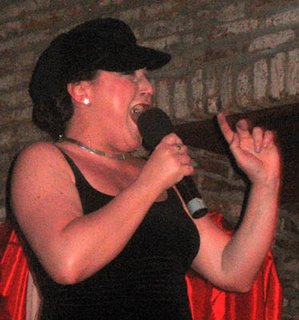 We all enjoyed María Noel's show on Friday evening. She sang a great mix of jazz standards in English, French, and Spanish.
We all enjoyed María Noel's show on Friday evening. She sang a great mix of jazz standards in English, French, and Spanish. The magazine, Galería de Busqueda, had a very nice feature on her in its most recent edition. (Sorry, no link: I couldn't find an online version of Busqueda.)
This post has a better photo of her and this post has a short video from an earlier show.
Watch a video clip from Friday's performance:
update: El Pais had a nice review in Wednesday's newspaper.
El nombre del talento: Maria Noel Taranto
HUGO GARCIA ROBLES
El pasado viernes primero de diciembre, la acogedora salita de La Colmena fue el marco para la presentacion del CD Divinas divas de Maria Noel Taranto.
La cantante tiene detras de si una trayectoria que la senala en el panorama de la musica popular del pais con personalidad propia y, ademas, imbricada en estilos y ambitos no muy transitados.
Sunday, December 03, 2006
Pasta
 I've really enjoyed the food in Uruguay-- which you may have noticed from my posts on el horno, la parilla, and other places. I've tended to focus on the beef, which is excellent, at the expense of the pasta which is also excellent. Many little shops specialize in fresh pasta and it's also available in all the supermarkets and nearly all the restaurants.
I've really enjoyed the food in Uruguay-- which you may have noticed from my posts on el horno, la parilla, and other places. I've tended to focus on the beef, which is excellent, at the expense of the pasta which is also excellent. Many little shops specialize in fresh pasta and it's also available in all the supermarkets and nearly all the restaurants. We've had ravioli, canelones, tortelines, capilletis, and sorrentinos filled with ricotta, other cheeses, meat, chicken, ham, vegetables and more. The noodles are yellow, green (spinach), and orange (red bell pepper). Oh, I can't forget to mention the ñoquis (gnocchi).
Another benefit of immigration!
Labels: food and drink, Uruguay
Saturday, December 02, 2006
Graduation
 While the date seems wrong, the weather feels right for graduation. My daughter's school had a graduation ceremony for the sixth graders at the Teatro Metro, downtown. The kids sang songs in Spanish and English (including "It's Fun to Stay at the YMCA".) They also performed scenes from several plays, both in Spanish and English. The graduation itself was very familiar, complete with caps and gowns.
While the date seems wrong, the weather feels right for graduation. My daughter's school had a graduation ceremony for the sixth graders at the Teatro Metro, downtown. The kids sang songs in Spanish and English (including "It's Fun to Stay at the YMCA".) They also performed scenes from several plays, both in Spanish and English. The graduation itself was very familiar, complete with caps and gowns.It took a few hours to get from the honor guard to the throwing of the mortarboards and I was worried I'd be late for lunch at the Club de Pesca, but I arrived just as Tito was ready to serve oven-roasted lamb. I'm glad I made it.
Friday, December 01, 2006
Street Names
 I had real trouble remembering street names in Montevideo when we first arrived in Uruguay. Part of it was the length of the names. Almost any street named after a person uses both the first name and the last name and frequently a title or two. Remembering just the first name doesn't help the cab driver find your hotel.
I had real trouble remembering street names in Montevideo when we first arrived in Uruguay. Part of it was the length of the names. Almost any street named after a person uses both the first name and the last name and frequently a title or two. Remembering just the first name doesn't help the cab driver find your hotel. Major streets are commonly referred to by just the apellido (last name) but the street signs include all the names and titles. Sometimes this can be important. Ellauri is a fairly big street in our neighborhood (leading to Punta Carretas Shopping) and its full name is Jose E. Ellauri. There is a sidestreet near the zoo, also named Ellauri: Placido Ellauri.
Many of the streets are named after famous Uruguayans, but they weren't familiar names to me. After a while, I learned that names like Artigas or Rivera are the equivalent of Washington or Jackson. Some names are still unfamiliar like, President and General Óscar Diego Gestido. (Of course that's true in the U.S. as well. Westnedge Avenue is a major street in Kalamazoo but I didn't know it was named for Colonel Joseph Burchnall Westnedge until I started writing this post.)
The other street names that gave me problems were the dates. 21 de Setiembre, 8 de Octubre, 26 de Marzo all sounded about the same to me. My Uruguyan history still isn't good enough to tell you what happened on those dates, but now I can remember which street has the headquarters of the Club Nacional.
I'm glad our street is La Rambla.
Labels: Montevideo places, Uruguay
archives
- June 2006
- July 2006
- August 2006
- September 2006
- October 2006
- November 2006
- December 2006
- January 2007
- February 2007
- March 2007
- April 2007
- May 2007
- June 2007
- July 2007
- August 2007
- September 2007
- October 2007
- February 2008
- March 2008
- April 2008
- May 2008
- July 2008
- August 2008
- September 2008
- October 2008
- February 2009
- April 2009
- July 2009
- December 2009
- April 2010
- February 2012
- March 2023
- April 2023


